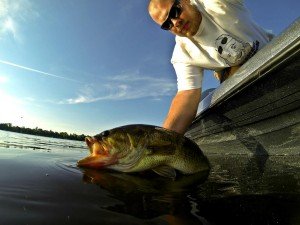Angling regulations will change on nearly three dozen waters this year, according to the Minnesota Department of Natural Resources.
Among the changes: Anglers will see more restrictive walleye regulations in and around Saganaga Lake in Cook County. Lake Winnibigoshish will have a relaxed, or narrower, protected slot limit for walleye. And northern pike special regulations will be removed on Big Birch Lake in Todd County.
Changed and new special and experimental regulations will be posted at public accesses on affected lakes and become effective March 1, except for those involving Sand Lake in Itasca County and connected waters, which will be effective in 2016.
 New regulations
New regulations
Saganaga, Sea Gull, and Gull lakes (Cook County) and connected waters – Walleye will have a 17-inch minimum length restriction and a bag limit of three established to protect small walleye to make the most of limited production of those fish from natural reproduction or stocking. Fish managers have been concerned for several years about low numbers of young walleye seen in these lakes, and the possibility that without some protection, those low numbers would result in even lower numbers of adult fish, with further reductions in spawning success. Effects of this regulation will be studied for the next 10 years, and will be reviewed with the public in 2024.
Sauk River chain of lakes (Stearns County) – Anglers will have an expanded opportunity to harvest channel catfish, which became established in the late 1970s and since have become very abundant. A bag limit of 10, but with only one of the 10 longer than 24 inches, is to provide the opportunity for more harvest yet still provide a healthy population of catfish.
Lake George (Hubbard County) – Bass will have a protected slot limit of 14-to 20-inches, with one longer than 20 inches allowed in a possession limit of six. The lake has a healthy population of bass shorter than 15 inches but fewer larger bass compared to other nearby lakes and the regulation is designed to boost numbers of larger bass.
Sand Lake (Itasca County) and connected waters (Birdseye, Portage and Little Sand lakes) –Starting in May of 2016, walleye will have a 17- to 26-inch protected slot limit with one fish longer than 26 inches allowed in a possession limit of six. This experimental regulation is intended to increase abundance of spawning-age walleye, stabilize reproduction, and end boom-and-bust cycles of fishing success for walleye. The regulation will be monitored for 10 years and its effect on walleye and fishing will be reviewed with the public in 2025.
Modified regulations
Lake Winnibigoshish – Walleye will have an 18- to 23-inch protected slot, with only one longer than 23 inches, relaxed from the previous 17- to 26-inch protected slot. This is to allow for more harvest opportunities while still maintaining protection to spawning-age fish. In recent years the slot limit on Winnibigoshish has consistently met objectives established for the regulation.
Clitherall and Sewell lakes (Otter Tail County) – On Clitherall Lake, smallmouth bass will have 14- to 20-inch protected slot limit with one longer than 20 inches allowed in a possession of six. This regulation replaces the catch and release regulation that has been in place for the last 10 years. The regulation for largemouth and smallmouth bass on Sewell Lake has also been changed to a 14- to 20-inch protected slot limit. This replaces the 12- to 20-inch protected slot limit. Both lakes have quality populations of bass but managers believe these lakes can sustain quality fish while allowing additional harvest for bass shorter than 14 inches.
Big Mantrap (Hubbard County) – Black crappie will no longer have a 10-inch minimum length restriction but will continue to have a restricted bag limit of five. The minimum length limit was determined to be ineffective at increasing the size of crappie in Big Mantrap Lake.
Dropped regulations
Special or experimental regulations will be dropped on four waters and return to statewide or border waters regulations.
Regulation objectives for improving northern pike in Big Birch Lake in Todd County; walleye and sunfish in Cottonwood Lake in Grant County; and sunfish in Mississippi River navigation pools 5, 5a, and 8 on Minnesota-Wisconsin border waters were not achieved, so special or experimental restrictions will be lifted.
For similar reasons, on Jewett and Pickerel lakes in Otter Tail County, bass regulations will return to statewide limits.
Regulations turning permanent
Three lakes that have had experimental or temporary emergency regulations will become permanent special regulations. Reduced bag limits of five sunfish on Pimushe Lake in Beltrami County and 10 sunfish on Star Lake in Otter Tail County were shown to have effectively maintained quality populations of sunfish.
The temporary catch-and-release regulation for a genetically unique population of lake trout in Mukooda Lake in St. Louis County was made a special regulation to conserve these fish for further study. On nearby Little Trout Lake, which also has a unique genetic population, there will be a new catch-and-release regulation for lake trout. Both lakes are accessible in Voyageurs National Park and anglers may travel through these lakes with lake trout legally harvested on other waters.
In most years, the DNR reviews the effectiveness of some existing regulations and also considers proposals for new regulations. After evaluating information collected from lake and angler surveys, the department takes public input before making decisions based on management goals.
by the Minnesota DNR